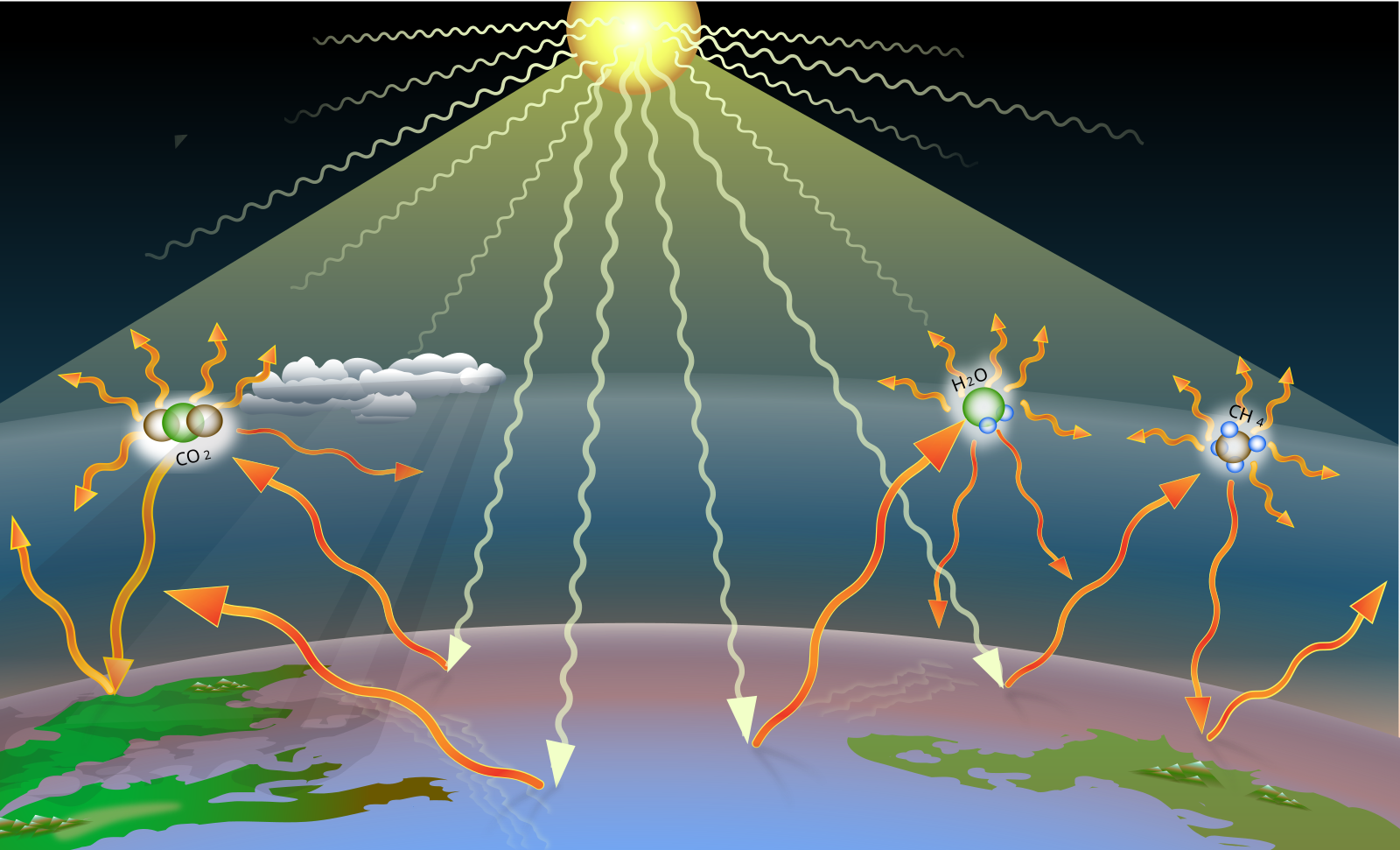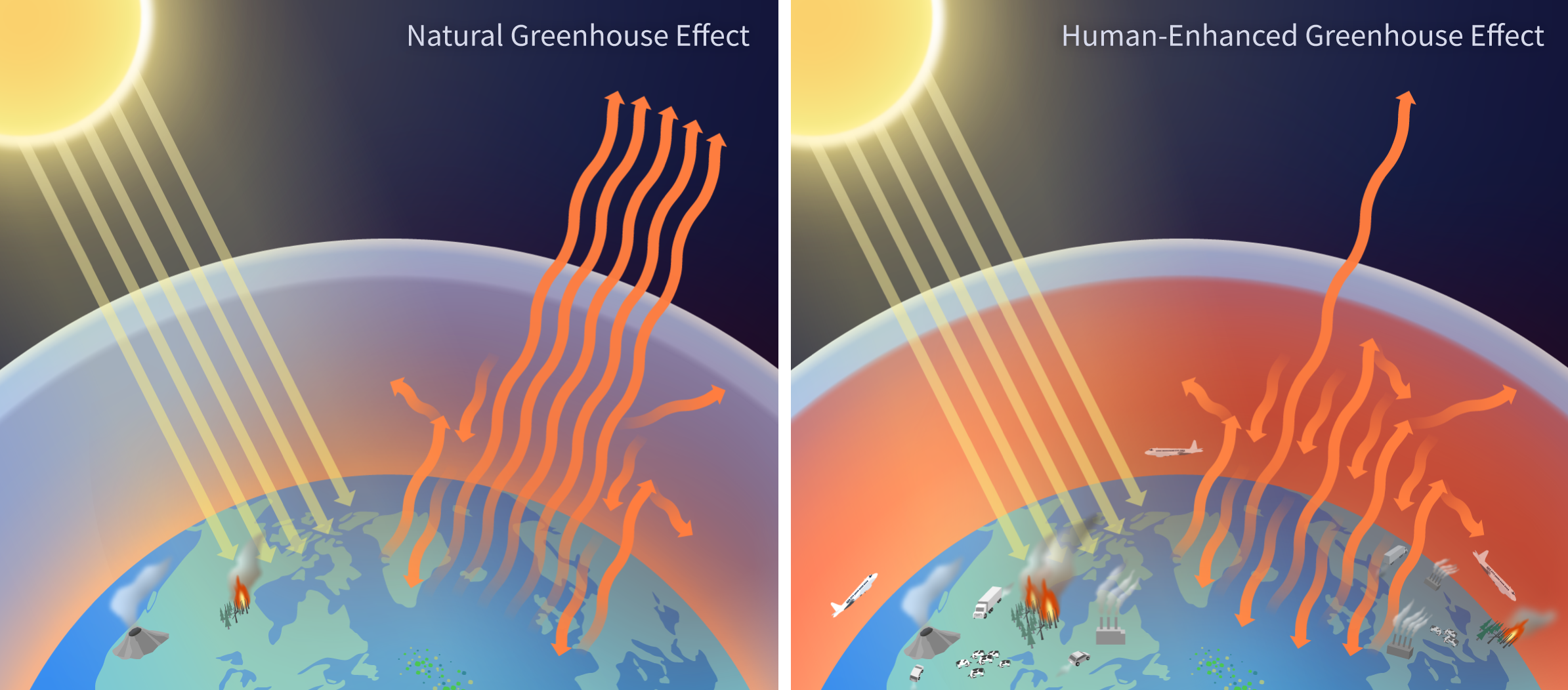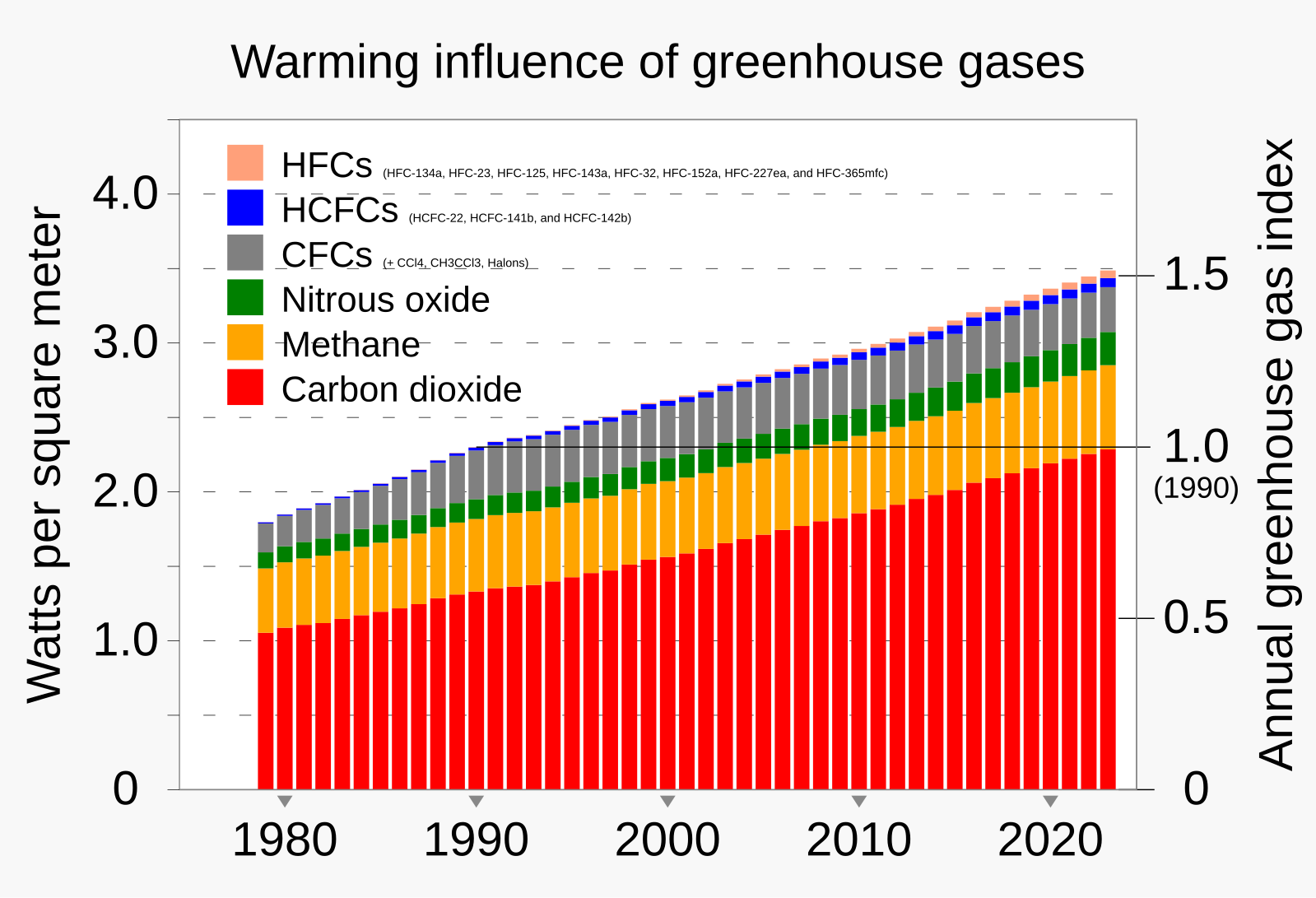IB Syllabus focus:
‘Natural greenhouse effect warms Earth; enhanced greenhouse effect from human-added GHGs raises mean temperature. “Climate change” includes warming plus wider system changes.’
The greenhouse effect is a vital natural process that maintains Earth’s habitable temperatures. Human activity has intensified this effect, producing an enhanced greenhouse effect that drives global climate change.
The Natural Greenhouse Effect
The natural greenhouse effect refers to the warming of Earth’s surface by atmospheric gases that trap outgoing longwave radiation. Without this effect, Earth’s mean surface temperature would be about –18°C rather than +15°C.
Key Greenhouse Gases
The main naturally occurring greenhouse gases (GHGs) include:
Water vapour (H₂O): Highly variable, amplifies warming through feedbacks.
Carbon dioxide (CO₂): Released through respiration, volcanic activity, and natural decay.
Methane (CH₄): Produced by wetlands and natural anaerobic processes.
Nitrous oxide (N₂O): Emitted through natural soil processes.
Greenhouse gases: Atmospheric gases that absorb and re-emit longwave infrared radiation, thereby contributing to the warming of Earth’s surface.
Mechanism of the Natural Effect
Solar energy enters Earth’s atmosphere as shortwave radiation (visible light).
Some energy is absorbed by Earth’s surface, warming land and oceans.
Earth re-emits energy as longwave infrared radiation.
GHGs absorb and re-emit some of this outgoing radiation, keeping Earth warmer than it would otherwise be.
This natural balance enables life to flourish.

Simplified schematic of the natural greenhouse effect: incoming solar shortwave radiation, surface warming, and re-emitted longwave radiation partially absorbed and re-emitted by greenhouse gases. Labels clearly distinguish energy pathways without unnecessary detail. Suitable for introducing the process before contrasting with the enhanced effect. Source.
The Enhanced Greenhouse Effect
The enhanced greenhouse effect refers to the strengthening of this natural process due to human activities, primarily since the Industrial Revolution. The burning of fossil fuels, deforestation, and agricultural expansion have sharply increased atmospheric concentrations of CO₂, CH₄, and N₂O.

Two-panel diagram comparing the natural greenhouse effect (left) with the human-enhanced effect (right) from added CO₂, CH₄, and N₂O due to fossil-fuel use and land-use change. Arrows and labels emphasise increased trapping of outgoing longwave radiation. Ideal for visually distinguishing natural versus enhanced processes. Source.
Anthropogenic Contributions
Fossil fuel combustion: Major source of CO₂.
Agriculture: Produces CH₄ (from livestock and rice paddies) and N₂O (from fertilisers).
Deforestation: Reduces CO₂ uptake by removing carbon sinks.
Industrial processes: Add synthetic GHGs such as CFCs, though these are regulated under treaties.
Enhanced greenhouse effect: The additional warming of Earth’s atmosphere due to increased concentrations of greenhouse gases from human activity.
Changes in Energy Balance
The natural effect maintains equilibrium between incoming solar energy and outgoing infrared radiation. Human activities disrupt this balance by increasing radiative forcing, the measure of energy imbalance caused by GHGs.
Radiative Forcing and Climate Change
Radiative forcing is a crucial concept in understanding how the enhanced effect drives climate change.
Radiative forcing: The change in energy flux in the atmosphere due to factors such as greenhouse gases, aerosols, or land use, expressed in watts per square metre (W/m²).
Positive radiative forcing (from CO₂, CH₄, N₂O, and black carbon) leads to warming, while negative radiative forcing (from aerosols and volcanic eruptions) temporarily cools the atmosphere.

Stacked bar chart of radiative forcing showing the aggregate warming influence of long-lived greenhouse gases since 1979, based on NOAA AGGI data. The graphic isolates contributions from CO₂, CH₄, N₂O, and halogenated gases; this gas-by-gas breakdown is an extra detail that illustrates the mechanism behind the enhanced effect. Clean labelling and scalable SVG format aid classroom use. Source.
Implications of the Enhanced Effect
The enhanced greenhouse effect is the primary driver of climate change, which includes not only global warming but also broader system changes. These include:
Rising mean global temperatures
Melting of polar ice and glaciers
Increased frequency and intensity of extreme weather events
Shifts in precipitation patterns
Rising sea levels due to both ice melt and thermal expansion
Distinguishing Natural and Enhanced Effects
Natural greenhouse effect: Essential for maintaining habitable conditions, stable over millennia.
Enhanced greenhouse effect: Human-driven, rapid, and destabilising, linked to industrialisation and exponential population growth.
Climate change: Long-term alteration of temperature and typical weather patterns in a region, encompassing global warming and associated environmental system changes.
Feedback Loops in the Enhanced Effect
The enhanced effect is amplified by positive feedback loops:
Water vapour feedback: Warming increases evaporation, raising atmospheric water vapour, which further enhances warming.
Ice-albedo feedback: Melting ice reduces reflectivity, allowing more absorption of solar energy, reinforcing warming.
Negative feedbacks, such as increased cloud cover reflecting sunlight, can counteract warming but are often weaker than positive feedbacks.
Human Recognition of the Distinction
Understanding the difference between the natural and enhanced greenhouse effects is central to IB Environmental Systems and Societies. While the natural process sustains life, the enhanced process threatens global stability.
Key points for students:
The natural effect is necessary, life-supporting, and stable.
The enhanced effect results from anthropogenic GHG emissions, producing rapid and destabilising climate change.
Climate change includes not only warming but also systemic alterations such as shifts in ecosystems, hydrological cycles, and atmospheric circulation.
FAQ
The Industrial Revolution marked the large-scale use of coal, oil, and gas for energy. This sharply increased atmospheric carbon dioxide concentrations beyond natural variability.
Deforestation to clear land for agriculture further reduced carbon sinks. Together, these changes disrupted the balance of the natural greenhouse effect and initiated the enhanced greenhouse effect.
Water vapour is the most abundant greenhouse gas, but its concentration in the atmosphere depends on temperature rather than direct human emissions.
As Earth warms from carbon dioxide, methane, and nitrous oxide, more water vapour evaporates, amplifying the effect through a feedback loop. Since humans cannot directly control water vapour levels, mitigation policies target other gases instead.
Natural changes in greenhouse gas levels, such as those during glacial cycles, occurred over thousands of years.
By contrast, modern increases since the mid-20th century have taken place within decades. This rapid rise leaves ecosystems and human societies less time to adapt to altered climatic conditions.
The natural greenhouse effect maintains stable conditions that have supported life for millennia.
The enhanced greenhouse effect introduces:
Higher average global temperatures
Greater variability in weather and climate patterns
Increased stress on natural and human systems
This destabilisation can trigger unpredictable feedbacks, making long-term system behaviour more difficult to model and manage.
The enhanced greenhouse effect increases global temperatures, which affect sea levels in two ways:
Thermal expansion: Warmer water expands, raising sea level.
Ice melt: Glaciers and polar ice sheets melt, adding water to oceans.
Both processes are accelerated by ongoing greenhouse gas emissions, leading to long-term impacts on coastal ecosystems and human settlements.
Practice Questions
Question 1 (2 marks)
Outline one difference between the natural greenhouse effect and the enhanced greenhouse effect.
Mark scheme:
1 mark for identifying the natural greenhouse effect as a life-supporting process that keeps Earth’s temperature suitable for life.
1 mark for identifying the enhanced greenhouse effect as the additional warming caused by human activity through increased greenhouse gas emissions.
Question 2 (5 marks)
Explain how human activities have contributed to the enhanced greenhouse effect and discuss two possible impacts of this on global climate systems.
Mark scheme:
1 mark for stating that human activities (e.g., fossil fuel combustion, deforestation, agriculture) increase atmospheric concentrations of greenhouse gases.
1 mark for naming at least one relevant greenhouse gas (e.g., CO₂, CH₄, N₂O).
1 mark for explaining the process of increased trapping of longwave radiation due to higher greenhouse gas levels.
Up to 2 marks for discussing impacts on global climate systems (e.g., rising mean global temperatures, altered precipitation patterns, sea-level rise, increased frequency of extreme weather events).
Maximum of 5 marks in total.

